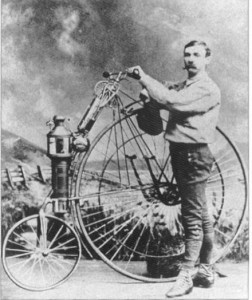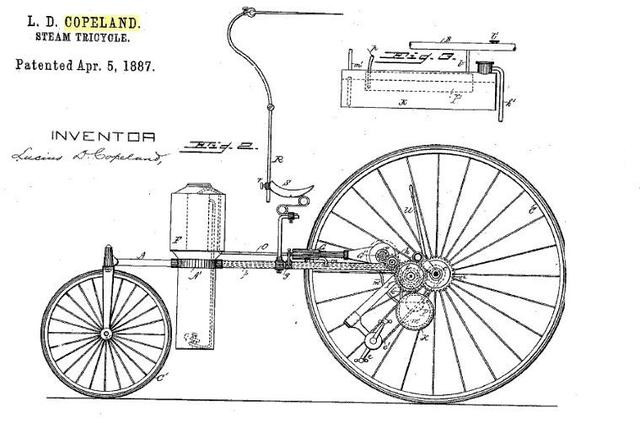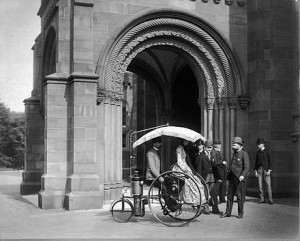Did you know that a pioneer in the early days of motorcycle creation in the 1880s had connections to Phoenix? It’s a fascinating piece of history!
Lucius D. Copeland, a mechanical engineer who played a role in installing the clock at the Maricopa County Courthouse in 1884, was more than just a clock technician. He was an inventor at heart. By July 1900, the Arizona Republican newspaper recognized Copeland as the inventor and operator of what they believed to be the first motorcycle in the western United States, and possibly even the world. While the global claim might be overstated, Copeland undeniably stands as one of the earliest innovators to successfully attach a motor to a bicycle frame. Although steam-powered models may not always be categorized as “true” motorcycles in modern terms, pioneers like Copeland significantly contributed to the design and evolution of motorized personal transport, marking a crucial phase in Pioneer Motoring.
 Lucius Copeland riding his pioneering steam bicycle in 1884, a key moment in early pioneer motoring history.
Lucius Copeland riding his pioneering steam bicycle in 1884, a key moment in early pioneer motoring history.
Copeland’s ingenuity involved using a Star bicycle frame, a popular design of the era, and integrating his own steam-powered engine. He showcased his creation, initially called a “steam bicycle” but soon to be known as the Copeland Steamer, at the Arizona Territorial Fair in November 1884. His invention was awarded a first premium, acknowledging its pioneering nature. Continuing his inventive streak, Copeland secured a patent in 1887 for a steam-powered tricycle. This led to the establishment of the Northrop Manufacturing Co. in New Jersey.
 1887 patent drawing of Lucius Copeland's steam tricycle, showcasing his innovative engineering in pioneer motoring.
1887 patent drawing of Lucius Copeland's steam tricycle, showcasing his innovative engineering in pioneer motoring.
Under Northrop Manufacturing, Copeland began producing the Phaeton Moto-Cycle, a vehicle capable of reaching speeds up to 12 miles per hour. By 1891, he had manufactured approximately 200 of these moto-cycles. However, finding the venture financially unsustainable, Copeland decided to step back from production and returned to Phoenix by 1895, once again listed in the city directory as a mechanical engineer.
 Copeland's steam tricycle displayed at the Smithsonian Institution in 1888, highlighting his impact on pioneer motoring and vehicle development.
Copeland's steam tricycle displayed at the Smithsonian Institution in 1888, highlighting his impact on pioneer motoring and vehicle development.
Lucius D. Copeland’s story is a testament to early innovation in personal transportation. To delve deeper into Copeland’s contributions, explore the Smithsonian Institution Archives article: “Full Steam Ahead: The Motorcycle’s Bicycle Beginnings“. For those in Phoenix, a replica of his Steamer is on display at the Arizona Science Center, offering a tangible link to this fascinating chapter in pioneer motoring history.

